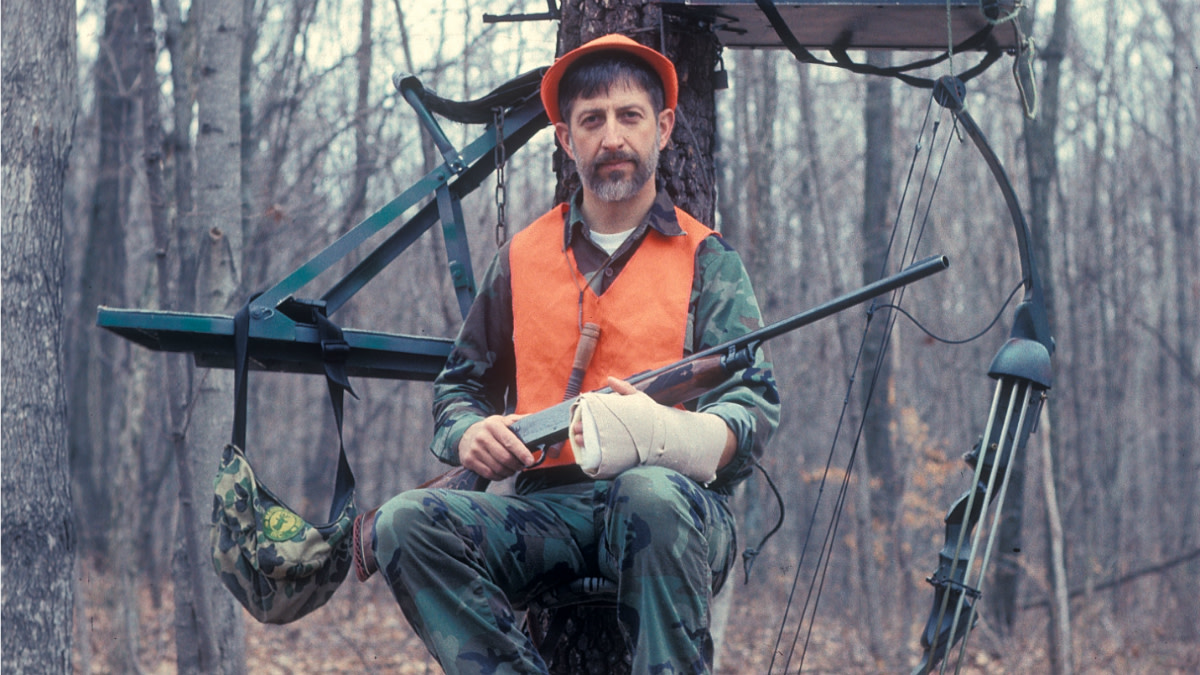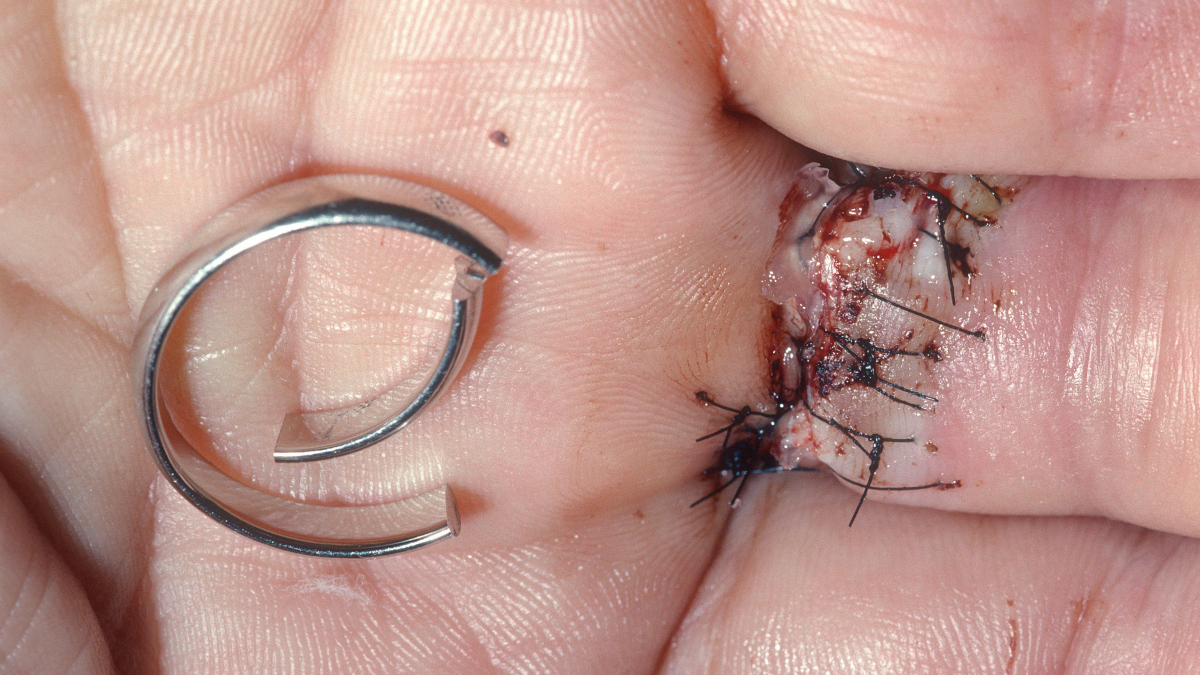
Thirty years after hopping 18 inches to the ground from a treestand’s lowest step one morning, Brad Herndon still studies the left hands of passing strangers to silently inventory mangled ring fingers.
That’s because Herndon can’t forget the searing pain caused by his wedding band that day in November 1989. As he hopped off that screw-in step after hanging a treestand near home in southern Indiana, his ring snagged the flat end of a step overhead as he dropped. The silver ring absorbed his full weight just long enough to bury itself into the flesh beneath his finger’s first knuckle. His ring slid free of the metal peg a split second later. If it had stuck, it likely would have snapped bone and severed vital veins and nerves.
Herndon and his wife, Carol, couldn’t see the wedding band on his pulpy, bloody finger as they raced to the hospital. They assumed the tree step had yanked it off, and that they’d have to search for it later. The emergency room doctor spared them the trouble. He found the ring jammed high into the bones and mashed flesh below the first knuckle on Herndon’s finger.
The doctor sawed through the ring in two places to remove it. He then sewed the finger back together with 14 stitches, and wrapped Herndon’s hand in a bandage that was “bigger than a grizzly’s paw.” Herndon said the finger hurt horribly for weeks as he took antibiotics and painkillers, and constantly changed the big bandages.
Herndon, now in his mid-70s, hasn’t worn a ring since. Neither has Carol. And the Herndons never again used screw-in tree steps. He regained full use and feeling in the finger within a few months, but never forgot the blazing pain and that clumsy club.
Dodging Amputation
Herndon never forgets how lucky he was, either. Although “finger avulsions”—the medical term for his injury—are rare, Herndon knows similar “deglovings” often cost people their entire finger or its full use. Even miracle-working microsurgeons can’t save most finger deglovings today. Amputation is usually required.
Comedian Jimmy Fallon knows something about Herndon’s kind of luck. He, too, suffered a finger avulsion in June 2015. “The Tonight Show” host tripped on a braided rug in his kitchen and caught his wedding ring on a table as he fell to the floor. He said the broken finger was bent sideways like a bad prop in a cheap horror movie. It required a vein transplant and six hours of microsurgery by an “amazing doctor wearing a bow tie and cowboy boots.”
Herndon, meanwhile, remains haunted by his accident. He compulsively examines the hands of strangers and new acquaintances for missing fingers and signs of traumatic injuries. “If you make a habit of looking, you’ll be shocked how many people are missing their ring finger,” Herndon said. “The rate is astonishingly high among farmers.”
Herndon shared his story in a 1990 issue of Deer & Deer Hunting Magazine, which brought another surprise. “It seemed like everyone had a horror story about rings, and they were all worse than mine,” he said.
“Well, a friend’s sister jumped off a truck’s tailgate and instantly felt a terrifying pain when she landed,” Herndon said. “Her wedding ring caught on a bolt sticking out of the truck bed. It broke her finger and pulled it right off. They couldn’t save it. They just sewed her up.”
Stories like those make Steve Rinella cringe, squirm and question the intelligence of anyone risking fingers to metal rings. “There’s certain things, certain injuries that just make my skin crawl,” Rinella said when asked why he raised the subject on the podcast during a live show in July 2018 near Minneapolis.
Rinella said he heard plenty of wince-worthy stories after telling friends about two scares involving his wedding band. First, he “welded” his metal ring to a boat battery in Alaska when his screwdriver arced on the battery’s terminals. Some time later, he hung up his ring in thick brush. After pulling free without injury, he realized he might not be so lucky a third time.
“I started looking at metal wedding rings as a potential source of harm,” Rinella said. “When I talked to other guys about it, they took it as an invitation to recount all their wedding ring intrigues; their what-ifs and worst-case scenarios. Their stories got me thinking, but I also wondered if it was a subconscious thing. Was I having these adversarial thoughts because of all the commitments a wedding ring entails? No, I decided that wasn’t it. I just didn’t want to weld myself to stuff and get the shit scared out of me.”
After dwelling on his fears about two years, Rinella told his wife he no longer wanted to wear his wedding band. She wasn’t having it.
“That was a nonstarter,” he said.
Steve’s wife countered by suggesting he get a tattoo of a wedding band so he’d forever carry a visible symbol of his marital status.
He rejected the idea. “There’s no way I was doing that.”
And so his worrying continued.
The Silicone Solution
Rinella’s wife ended his worries last summer with a four-pack of silicone rings for their 10th wedding anniversary. He laughs at the solution’s simplicity. “It took me about two years of worrying about it, and then two more years of hemming and hawing before making the $13 commitment to get a silicone ring,” he said. “Now I have a lifetime supply. My daughter calls it my fake wedding ring.”
Rinella enjoys his newfound role as a silicone advocate. “I love my silicone ring,” he said. “It’s the second best thing that’s ever happened to me. Getting married was the best thing. You can’t snag a silicone ring on anything, and it doesn’t clack on your gun or bow when you’re trying to be stealthy. It’s a thousand times more comfortable, and it doesn’t give you weird calluses from weightlifting. No one confuses it for gold, but I no longer have that liability of walking around with a hunk of metal on my hand. It’s ridiculous to wear metal rings.”
Unlike Herndon, Rinella doesn’t study strangers’ hands for trauma or missing digits. He does, however, notice rings on other people, and goofs on them about their choices. “When I see someone running a silicone ring, I think ‘There’s a smart, active fella,’” he said. “I’m more inclined to like him. Some people judge you by your hair or clothes. I go by your wedding ring.”
One man measuring up to Rinella’s standards is Dr. Alan Lazzara of Ann Arbor, Michigan. Lazzara was one of many listeners who contacted Rinella after hearing him discuss deglovings on the podcast.
Lazzara practices and teaches emergency medicine at Henry Ford Allegiance Health in Jackson, Michigan. He said he worries more about falls from treestands because they’re more common than deglovings. Still, Lazzara wears a silicone ring and won’t own rings made from tungsten carbide. Unlike other metals, tungsten can’t be cut. Tungsten rings must be cracked off with vice-grip pliers.
Lazzara said the worst degloving case he’s seen involved a woman who caught her lower arm in an industrial pet food grinder. The machine rolled down the skin from her elbow to her fingertips, where it remained attached.
Lazzara also suggests removing rings immediately if you injure, burn or break an arm, hand or finger. Injuries cause swelling that makes it difficult to remove rings, which can restrict blood to the fingers.
Rinella said many listeners also wrote to say police, firefighters, military personnel and anyone working around ladders, scaffolding or machinery can’t or shouldn’t wear metal rings or jewelry.
Emergencies are no time for sentimentality and superstitions, after all. Yes, folks in Western cultures have long thought it unlucky to remove wedding rings once they’re placed on fingers inside a church, but beliefs about wedding rings vary by time and place. Wedding rings trace to at least 300 or 400 B.C., and have long been worn on the fourth finger of the left hand because ancient people thought a vein in that finger—the “Vena amoris,” or vein of love—led straight to the heart.
Metals also weren’t available to most ancient people, so they used hemp, bone, ivory or leather for wedding rings. It’s thought early Romans were the first to fashion metal wedding bands, but they usually used iron. When using gold or silver, which was rare, a man showed he trusted his wife with his valuable property.
Another big change occurred the past 50 to 100 years. Until the 1900s, men weren’t expected to wear wedding bands. In fact, my then-fiancé asked in 1980 whether we should buy a matching gold ring for me.
At eternal risk to the fourth finger on my left hand, I said yes. I haven’t removed it since.
Feature image via Chris Herndon.







Conversation